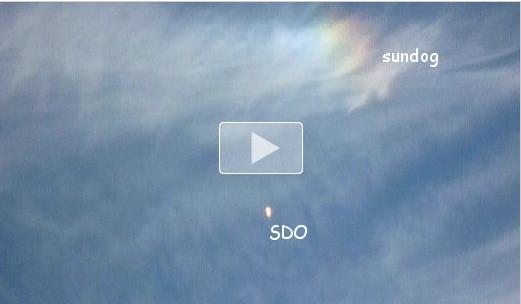12 February 2011
Solar Dynamic Observatory Launch Leads to Atmospheric Optics Discovery!
Posted by Dan Satterfield
Hang on, here come the wild parts:
First the shock waves from the booster DESTROYED the visible sun dog! The reasons, according to NASA scientists who investigated this, are well known. The waves destroyed the alignment of the ice crystals and the sun dog disappeared.
You can see this in the movie below, but run the movie twice and you will see a reflection of light form to the LEFT of the rocket. Les Cowley and his colleague Robert Greenler saw this and could not explain it. Les is an expert on atmospheric optics and runs the best internet page ever on the subject.
This started an investigation that at first had no luck. Models of the ice crystals did not explain it until they had a bright idea. The ice crystals were behaving like a child’s toy. A “top” to be exact.

Simulation of the halo produced as the Solar Dynamics Observatory passed throught he cirrus deck. You are seeing just a little bit of the halo in the launch movie. Click to see the full resolution image.
Crowley explains it in a NASA Science News article out today:
Simulation of the halo produced as the Solar Dynamics Observatory passed through the cirrus deck. You are seeing just a little bit of the halo in the launch movie. Click to see the full resolution image. “The crystals are tilted between 8 and 12 degrees. Then they gyrate so that the main crystal axis describes a conical motion. Toy tops and gyroscopes do it. The earth does it once every 26,000 years. The motion is ordered and precise.”
In effect, the shock waves that destroyed the sundog did the opposite to the crystals to the left: they caused them to spin an gyrate and produced a halo. You are actually seeing only a part of the halo, according to Cowley and Greenler. Look at the image on the right and you can see what their modeling produced.
This is the kind of thing that makes atmospheric scientists jump up and down and giggle with delight. I hope you think that this is as cool as I do! Kudos to Les Cowley and Robert Greenler for advancing science by just simply watching a rocket launch, and asking one question: WHY?




 Dan Satterfield has worked as an on air meteorologist for 32 years in Oklahoma, Florida and Alabama. Forecasting weather is Dan's job, but all of Earth Science is his passion. This journal is where Dan writes about things he has too little time for on air. Dan blogs about peer-reviewed Earth science for Junior High level audiences and up.
Dan Satterfield has worked as an on air meteorologist for 32 years in Oklahoma, Florida and Alabama. Forecasting weather is Dan's job, but all of Earth Science is his passion. This journal is where Dan writes about things he has too little time for on air. Dan blogs about peer-reviewed Earth science for Junior High level audiences and up.
[…] This post was mentioned on Twitter by Chris Rowan, Dan Satterfield. Dan Satterfield said: Launch of Solar Dynamics Observatory leads to Atmospheric Optics Discovery: http://bit.ly/i8D9yL #space #science #sundogs […]